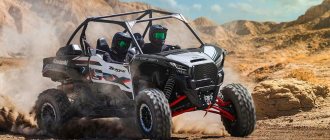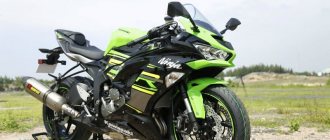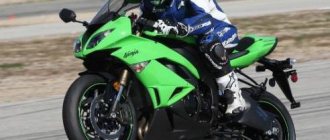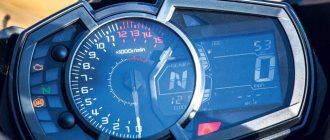Appearance
The motorcycle looks catchy. Stylish alloy wheels and a characteristic large exhaust pipe immediately make it clear that this is a sports car. As well as the characteristic shape of the frame with a completely closed filling. The shapes are sleek and aerodynamic, reflecting the model's modern origins as the angularity of the Eighties has fallen out of fashion. This is not surprising, because the higher the speed, the higher the requirements for frame bending.
Judging by the photos and videos, the car looks best on the race track. It has a very sporty design for an urban environment, and therefore sometimes such a motorcycle looks ridiculous against the backdrop of some ordinary residential areas. However, if these are neat townhouses, such a bike looks even more or less appropriate.
Comfort
The model is convenient for those who are used to riding sports motorcycles. The only possible riding position for this bike is crouched, reclining. This is due to the large distance between the steering wheel and the seat, as well as the high gas tank. This is normal, because the motorcycle is designed for high speeds and strong acceleration, for which only this position is appropriate.
Since the bike is still in production today, parts for it are easy to obtain. Therefore, maintenance will not be difficult. Plus, if you only use the bike for occasional rides on the race track, it's unlikely that anything will break down anytime soon. Like many other Kawasaki bikes, this model is very reliable.
The car also has good visibility through the windshield. It is unlikely that you will be able to look at the road differently at high speed. Already after the bike reaches 130 km/h the driver will begin to blow away if he does not bend down and take cover behind the glass. This or that description of sports models mentions this more than once.
Half a million Russian rubles is how much such a model costs. This is a lot of money for most, and therefore for many it would be more expedient to buy a cheaper sportbike. Also, do not forget that this machine is in no way suitable for off-road use, and for these purposes it is worth buying a motocross motorcycle.
Specifications
The stuffing of this bike is so powerful that it makes it dangerous for beginners. It’s probably worth getting on such a vehicle only after a weaker sportbike. Then the person will be more or less prepared for local acceleration and maximum speed. And also to management during these periods.
| Motor type | in-line, 4 stroke, 4 cylinders |
| Power | 213 hp |
| Torque | 114.9 Nm |
| Maximum speed | 299 km/h |
| Acceleration to 100 | 2.8 s |
| Fuel consumption per hundred | 5.6 l |
| Drive unit | chain |
| Transmission | six-speed |
| Frame | aluminum |
| Rear suspension | pendulum, monoshock absorber, stroke 115 mm |
| Front suspension | inverted fork, 43 mm, 120 mm travel |
| Rear brakes | 1 disc, 220 mm, 1-piston caliper |
| Front brakes | 2 discs, 330 mm, 4-piston calipers |
The technical characteristics here are excellent for a sports model. Both the brakes and suspension are carefully selected taking into account the power and torque of the engine, as well as the dimensions. So in terms of filling there is nothing to complain about.
Victor Kryukov
AES-Moto technical center specialist
When designing the power unit, Kawasaki engineers placed the rotation axes of the crankshaft, primary and secondary transmission shafts not along one line, as usual, but at the corners of an imaginary triangle, which made it possible to significantly reduce the length of the internal combustion engine. The cylinder block is integrated with the crankcase to reduce the weight of the structure and increase its rigidity, and behind it is a three-phase brushless alternator. The use of a compact high-speed power supply reduces the width of the motor. More features of the “ninja heart”: Parts of the 16-valve gas distribution mechanism made of chrome-molybdenum steel. Pistons are “forged” (made from a die-stamped billet). 4 valves per cylinder for better purging, camshafts with specifically selected phases. Everything indicates that the motor was designed to operate in a mode close to the “cut-off”, which is confirmed by measurements on the bench - peak torque occurs at 11,754 rpm, peak power at 13,396 rpm. A slight dip in the torque curve after 12,000 rpm can be eliminated by replacing the exhaust with a direct-flow one. Refinement of the exhaust system will allow you to cross the line of 200 horsepower, but a miracle will not happen: at speeds up to 4000–5000 rpm, the torque will “fall” even more.
What do motorcycle owners say?
Today there are many who bought a new Kawasaki ZX-10R, as well as used owners. The latter write about various problems that owners of new bikes do not face. This means that the issue is most likely due to careless handling.
Many residents of the Moscow region really like this bike because it is relatively convenient for the city and pleasant for riding on country roads. However, residents of remote regions where the roads are not in the best condition say that this car is not suitable for this.
Judging by the reviews of those who bought this sports bike exclusively for riding on race tracks, that's where the ZX-10R performs best. At high speeds, handling is excellent, road grip is good, and in any reasonable riding position, the indicators on the dashboard are clearly visible.
In conclusion, it is important to note that the Kawasaki ZX-10R is a sportbike that has already proven itself. So if you want a bike from this category, but don’t have enough money for new items, you should take a closer look at this still relevant motorcycle.
Kawasaki ZX-10R
The flagship “liter” sportbike Kawasaki ZX-10R literally from its birth in 2004 received the status of a riot. He was considered such until his retirement in 2010. What should you look for when choosing such a specimen and how is its reliability?
STORY
At the presentation of the 2004 ZX-10R Ninja, Kawasaki's top officials were literally stunned by declaring that they had created the most energy-efficient sportbike in its category. After all, the 998 cm³ inline four with two throttle valves per cylinder, six-speed gearbox and slipper clutch produced 175 hp with a compression ratio of 12.5:1. and 115 Nm, despite the fact that the motorcycle itself, together with technical fluids and fuel, weighed only 196 kg, and without them - 170 kg. At the same time, in order to combine exciting handling with stability at high speed, they used a combination of an ultra-short wheelbase (1385 mm) and a long pendulum. The frame itself was welded from several castings with a wall thickness of 2.5 mm.
True, Kawasaki’s “litrosport” turned out to be so wild and unbridled that two years later the engineers decided to tame it a little, keeping the impact at the same level. They made the crankshaft heavier, increasing its inertia. For the sake of mass centralization, the engine was moved upward, and the cylinder block was tilted from 20° to 23°. The injection was equipped with diffusers with a diameter of 43 mm and other nozzles (they spray fuel into particles with a diameter of 50 microns). The generator was moved to the toe of the crankshaft, and the titanium exhaust system was moved to the tail.
The chassis was also redesigned point by point. First of all, we strengthened the steering column mounting point on the frame. A wear-resistant DLC coating was applied to the movable tubes of the fork legs, which reduces friction. The design of the rear suspension pendulum was completely redesigned (the reinforcing belt was placed not at the top, but at the bottom), as a result of which the wheelbase increased to 1390 mm (+5 mm). An Öhlins steering damper was included as standard equipment, and the front brake master cylinder was replaced with a radial-type unit.
In 2008, the time came for another modernization. The main innovation in the design of the ZX-10R engine is the transition to an injection system with two injectors per cylinder. Other changes include modified cylinder head ports and combustion chamber. The designers paid their tribute to universal liposuction by reducing the crankshaft mass by one kilogram, while the moment of inertia remained the same - due to the changed geometry of the counterweights. As a result, the power curve jumped to 188 hp. at 12,500 rpm. However, the exhaust, which returned to the right side and complied with Euro-3 environmental standards, led to the fact that the motorcycle became heavier to 179 “dry” kg.
The frame's configuration of elements in the area of the steering column and their casting technology were once again revised, and the lengthened pendulum (base - 1415 mm) returned to the design with an upper reinforcing belt. An adjustable two-pipe Öhlins damper appeared. The diameter of the petal-type front brake discs has increased from 300 to 310 mm.
In this form, the ZX-10R remained on the production line until the end of 2010, after which it was superseded by a completely different motorcycle.
FOR WHAT
The attitude towards the first generations of the “ten” has always been ambiguous. Even when new, they always remained committed to the “old school”: fiery-sharp in the engine, rock-solid in the chassis, analog in the controls and extremely demanding of skills. Early ones are more, late ones are less.
There is no desire to try the “four” with the middle range also because instead of traction, it is a complete drag. Plus, the ZX-10R's overly stretched gear ratios make it painfully slow to select each gear. Where on another “liter” sportbike you manage to shift into high gear between traffic lights, on a Kawasaki you barely get close to the rev limiter.
Willy-nilly, the “ten” forces you to change your driving style to a much more aggressive one: with lower gears and gas earlier. After all, the “sport liter” opens only under full throttle, when the tachometer exceeds 7000 rpm. At that moment, the green alien fills the air filter and angrily rushes into the thick of the sleepy townspeople, accompanying the entire performance with a hysterical howl. Then the horizon begins to approach with unprecedented speed, and numerous “horses” frantically tear the front wheel upward. On landings, however, you should keep your eyes open, your trajectory straight, and your hands relaxed: Kawasaki really likes to shake the fork.
Handling in general does not cause criticism: the ZX-10R pleases with lightning-fast reactions and exemplary neutral steering. Although for typical routes “home - work - cafe - home” the basic suspension settings may seem harsh, and for the track they may not be refined enough (at exits from turns and at speeds above 230 km/h, the Ninja expands the dynamic corridor and tends to jump off the trajectory, and hard braking produces an unpleasant vibration on the steering wheel).
By the way, ZX-10R fans themselves rank the first three generations in the following order: the E8F, E9F and FAF versions (2008-2010) are considered the most universal, the most inconspicuous are the D6F and D7F (2006-2007), and the most exciting are the C1H and C2H ( 2004-2005).
CHOICE
There is an opinion among ZX-10R owners that since the inline-four was created with racing in mind, in ordinary life it can run more than tens of thousands of kilometers. It's like that. But only with careful care (scheduled maintenance with replacement of process fluids and consumables, checking valve clearances, etc.) and constant attention to the oil level (certain specimens were noted to have a talent for wasting it in all ways known to science). Unnecessary savings and negligence lead to clogged channels and a drop in oil level. Next is the rotation of the liners and the crankshaft wedge. And for dessert - scuffs on the camshaft journals and their beds.
The “ten” engine is known for structural innate vibrations, which not only numb the hands, but also affects the throttle valve block, forcing one to resort to balancing and synchronization much more often than prescribed periods. You can slightly calm them down on the steering wheel by installing heavier weights (this was done on the D7F generation). But if the vibrations suddenly become more noticeable, then in order to avoid serious problems, it makes sense to inspect the thrust washer on the generator shaft.
Some hotheads manage to burn the clutch in less than 3000 km. This is partly due to the overly aggressive manners of the engine, but more often it is due to inept attempts to lift the motorcycle onto the rear wheel. If you suddenly feel the first signs of slippage, then it is better not to put off repairs: degradation and subsequent death occur rapidly. It’s good that you will most likely have to change one or two discs, and not the entire clutch package.
Taking into account the eccentric nature of motorcycles produced in 2004-2005, the presence of a non-standard steering damper on them is a common occurrence: you just need to make sure that it does not in any way limit the angle of rotation of the steering wheel and does not touch anything. But the discovery of a quickshifter should at least alert you: the ZX-10R gearbox is already famous for its fragility (cases of breakdowns are known after a mileage of 15-17 thousand km), and its use can become a trigger for increased gear wear.
However, these are all flowers. The berries are an aluminum frame. The fact that it cracks at the welds in and around the gas tank was first noticed on the C1H (2004) and C2H (2005) generations. Moreover, it didn’t matter whether the ZX-10R was driving on the track or logging kilometers on the streets. We must pay tribute to the Japanese, although they did not announce a recall campaign; each request was recognized as a warranty case and, without any questions asked, they replaced the defective old-style frame (part number 32160-0021-8F) with a modernized part (32160-0132-8F). One thing is sad - the measures taken to strengthen the frames still turned out to be half-hearted: cracks periodically occur on all generations of the “ten”, produced between 2004 and 2010. Officially, the recall was announced only once - for the ZX-10R, produced in 2004. The reason is a batch of defective front wheels with casting defects that got onto the conveyor.
The Tokico front brakes also have a hard time: being cold, they demonstrate excellent grip, but on the track or mountain serpentine they deflate unforgivably early. Replacing the standard pads with something more resistant to overheating (for example, Brembo SA and SC are suitable for streets, and Brembo RC and Z04 for the “ring”), and replacing rubber hoses with reinforced ones only partly solves the problem. The most effective treatment is the implantation of calipers from the ZX-10R model 2008-2015. In addition, like any mechanism, Kawasaki brakes love caress, cleaning and lubrication. This means that during each maintenance we unscrew the calipers and remove all dirt from the surfaces of the pistons.
Old age comes to electronic components without surprises and manifests itself in corroded contacts, missing mass and wiring breaks. One example is a red light that lights up for no reason, which signals a drop in oil pressure, due to the short-circuit terminals of the sensor, the rubber cap of which tends to collect water. Another is a breakdown of the relay-regulator, after which the generator usually also dies. The third is a failure of the ignition switch.
And finally, it would be nice to take a closer look at the appearance and details. Firstly, the quality of the paintwork is hardly one of the strengths of the brand: the engine, frame, fork stays, fasteners and even brake calipers become covered with oxides, scuffs and ulcers over time. And secondly, the marks on the body of a sportbike can tell both about the falls experienced and about the active “ring” life: plastic that is fresh beyond its years (or Chinese), pinpoint damage from gravel, plugs and calipers sealed with wire, scratches on the wheels from frequent use. re-bulking and so on.
TUNING
The age of the model makes itself felt, so you can’t count on a wide range of accessories. Although with some diligence you can still find a lot of things. Suspension Öhlins, K-Tech and Bitubo (cartridges in the fork or entire stays, springs of different stiffnesses and monoshock absorbers), wheels Marchesini, BST, Galespeed, OZ and Carrozzeria (cast, forged, aluminum, magnesium and carbon), Brembo brakes (calipers, discs and brake master cylinders), Yoshimura racing kits, glass, footrests, levers... Enough money! And the skill to bring it all from foreign online stores to Russia.
WHERE TO LOOK
The search location depends solely on your income. You can start with offers from private individuals, among which there are traditionally both outright rubbish and tempting options. If you want equipment without mileage in the CIS, then numerous “gray” importers will be happy to bring it from Japan, the USA and Canada.








